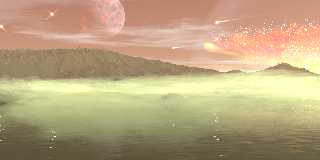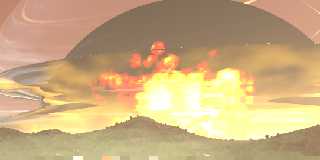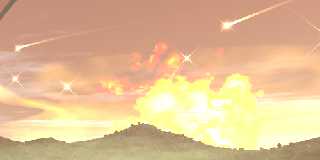 |
 |
|
 |
|
 |
|  |
|  |
|
 |
From: Thomas de Groot
Subject: Re: Early Earth: The Late Heavy Bombardment [final image]
Date: 10 Jul 2012 07:32:34
Message: <4ffc12d2$1@news.povray.org>
|
|
 |
|  |
|  |
|
 |
On 10-7-2012 10:07, Paolo Gibellini wrote:
> >Thomas de Groot on date 09/07/2012 14.03 wrote:
>> This should be the final development of the scene.
>>
>> Thomas
> Ooh.
> The explosion is less terrifying (due to the daylight), but the sea and
> the fog are very convincing.
> ;-)
Thanks Paolo. I am still terrified though ;-)
I am adding a spherical shock wave to complete the impact.
For the fog over the water I used a df3 file made with Gilles Tran's
MakeCloud.
Thomas
Post a reply to this message
|
 |
|  |
|  |
|
 |
From: Thomas de Groot
Subject: Re: Early Earth: The Late Heavy Bombardment [final image]
Date: 11 Jul 2012 07:32:20
Message: <4ffd6444@news.povray.org>
|
|
 |
|  |
|  |
|
 |
This is really the final image. Added a spherical shock wave.
Thomas
Post a reply to this message
Attachments:
Download 'earlyearth - lhb_final.png' (835 KB)
Preview of image 'earlyearth - lhb_final.png'

|
 |
|  |
|  |
|
 |
From: Alain
Subject: Re: Early Earth: The Late Heavy Bombardment [final image]
Date: 11 Jul 2012 16:30:51
Message: <4ffde27b$1@news.povray.org>
|
|
 |
|  |
|  |
|
 |
> This is really the final image. Added a spherical shock wave.
>
> Thomas
I have some problem with that shock wave: It don't difract light.
A shell with an ior of about 1.1 to 1.17 would be more convincing.
Alain
Post a reply to this message
|
 |
|  |
|  |
|
 |
From: Thomas de Groot
Subject: Re: Early Earth: The Late Heavy Bombardment [final image]
Date: 12 Jul 2012 04:43:33
Message: <4ffe8e35@news.povray.org>
|
|
 |
|  |
|  |
|
 |
On 11-7-2012 22:31, Alain wrote:
> I have some problem with that shock wave: It don't difract light.
> A shell with an ior of about 1.1 to 1.17 would be more convincing.
>
This gets me into problems :-(
For the example I switched off the solid ejecta. I also tuned down the
fog over the water.
For the shock wave I used an ior of 1.01. Obviously, now its media
interacts with the other media inside, especially the dust ejecta
container. Higher ior makes it worse.
Thomas
Post a reply to this message
Attachments:
Download 'earlyearth - lhb.png' (159 KB)
Preview of image 'earlyearth - lhb.png'

|
 |
|  |
|  |
|
 |
From: Alain
Subject: Re: Early Earth: The Late Heavy Bombardment [final image]
Date: 12 Jul 2012 18:49:11
Message: <4fff5467$1@news.povray.org>
|
|
 |
|  |
|  |
|
 |
> On 11-7-2012 22:31, Alain wrote:
>> I have some problem with that shock wave: It don't difract light.
>> A shell with an ior of about 1.1 to 1.17 would be more convincing.
>>
>
> This gets me into problems :-(
>
> For the example I switched off the solid ejecta. I also tuned down the
> fog over the water.
>
> For the shock wave I used an ior of 1.01. Obviously, now its media
> interacts with the other media inside, especially the dust ejecta
> container. Higher ior makes it worse.
>
>
> Thomas
>
It looks like a solid, full, shell. Make the shock wave shell as a
difference of 2 spheres.
To bad we can't have variable ior, as in this case, it should go from 1
(in the air in front of the wave), raise in an S shape to maybe around
1.1, then drop slightly under 1 before returning to 1.
You may also try playing giving the area inside the sinside an ior
slightly less than 1, like 0.98 to 0.995...
Alain
Post a reply to this message
|
 |
|  |
|  |
|
 |
From: Thomas de Groot
Subject: Re: Early Earth: The Late Heavy Bombardment [final image]
Date: 13 Jul 2012 03:45:12
Message: <4fffd208$1@news.povray.org>
|
|
 |
|  |
|  |
|
 |
On 13-7-2012 0:49, Alain wrote:
> It looks like a solid, full, shell. Make the shock wave shell as a
> difference of 2 spheres.
I did too but that was not better, rather worse.
> To bad we can't have variable ior, as in this case, it should go from 1
> (in the air in front of the wave), raise in an S shape to maybe around
> 1.1, then drop slightly under 1 before returning to 1.
Yes, that would be cool.
>
> You may also try playing giving the area inside the sinside an ior
> slightly less than 1, like 0.98 to 0.995...
Yes, I tried too. It corrected somewhat the inner media but did not
change the chock wave appearance.
I shall still make a couple of experiments.
Thomas
Post a reply to this message
|
 |
|  |
|  |
|
 |
From: Thomas de Groot
Subject: Re: Early Earth: The Late Heavy Bombardment [final image]
Date: 13 Jul 2012 10:56:22
Message: <50003716@news.povray.org>
|
|
 |
|  |
|  |
|
 |
The best I can get at this stage (no good) using a differenced sphere
for the shock wave. Diffractions looks ok at the border but I cannot get
the transparency of the sphere right. The cloud layer is also
differenced (a tiny bit larger sphere) to ensure that no clouds are
present inside the shock wave.
Code snippet:
difference {
sphere {0, 1
hollow
texture {pigment {rgbt <1,1,1,1>} }
interior {
ior 1.1
media {
intervals 1
samples 10, 1000
scattering {1, 0.000025
extinction 1
}
}
}
}
sphere {0, 0.98
hollow
texture {pigment {rgbt <1,1,1,1>} }
interior {
ior 1.0
}
}
scale MediaScale * 1.52
translate <CamLoc.x, CamLoc.y, 5000> + <2800, 0, 0>
}
Thomas
Post a reply to this message
Attachments:
Download 'earlyearth - lhb.png' (114 KB)
Preview of image 'earlyearth - lhb.png'

|
 |
|  |
|  |
|
 |
From: Thomas de Groot
Subject: Re: Early Earth: The Late Heavy Bombardment [experimental image #2]
Date: 14 Jul 2012 04:01:22
Message: <50012752@news.povray.org>
|
|
 |
|  |
|  |
|
 |
Trying to get at the problem. I here switched off the sphere
representing the sky and the atmospheric media. Also corrected the shock
wave container as follows:
//start code
difference {
sphere {0, 1.00 hollow}
sphere {0, 0.98 hollow}
material {
texture {pigment {rgbt <1,1,1,1>} }
interior {
ior 1.1 //shock waved air
media {
intervals 1
samples 10, 1000
scattering {1, 0.0001
extinction 1
}
}
}
}
scale MediaScale * 1.52
translate <CamLoc.x, CamLoc.y, 5000> + <2800, 0, 0>
}
//end code
While one can see /inside/ the shock wave, it is not possible to see the
stars through the opposite end of the sphere... why?
Thomas
Post a reply to this message
Attachments:
Download 'earlyearth - lhb.png' (145 KB)
Preview of image 'earlyearth - lhb.png'

|
 |
|  |
|  |
|
 |
From: Thomas de Groot
Subject: Re: Early Earth: The Late Heavy Bombardment [experimental image #3]
Date: 14 Jul 2012 08:13:06
Message: <50016252@news.povray.org>
|
|
 |
|  |
|  |
|
 |
OK. Got the transparency solved. Just a stupid max_trace_level issue :-(
Next problem is to get rid of this sphere edge seen in cross section...
Thomas
Post a reply to this message
Attachments:
Download 'earlyearth - lhb_.png' (144 KB)
Preview of image 'earlyearth - lhb_.png'

|
 |
|  |
|  |
|
 |
From: clipka
Subject: Re: Early Earth: The Late Heavy Bombardment [experimental image #2]
Date: 14 Jul 2012 08:47:06
Message: <50016a4a$1@news.povray.org>
|
|
 |
|  |
|  |
|
 |
Am 14.07.2012 10:01, schrieb Thomas de Groot:
> While one can see /inside/ the shock wave, it is not possible to see the
> stars through the opposite end of the sphere... why?
max_trace_level maybe?
Post a reply to this message
|
 |
|  |
|  |
|
 |
|
 |
|  |




![]()